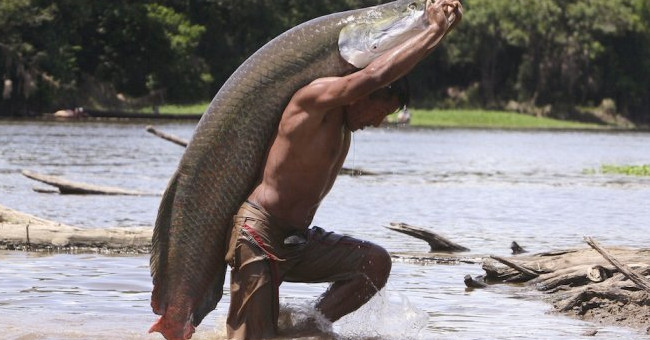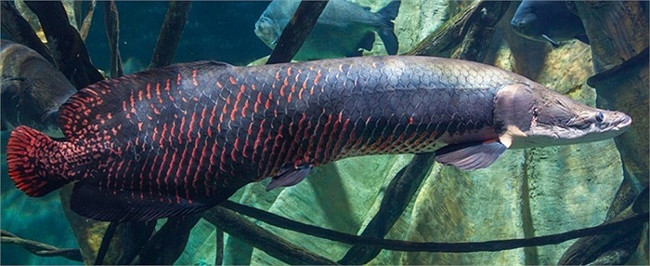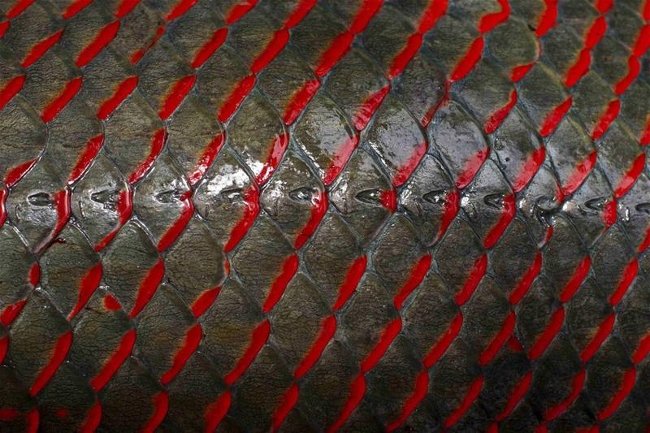Close-up of the species
Many people will be surprised by the frightening giant shape of the world's largest freshwater "water monster".
Marine fish - The world's largest freshwater fish in the Amazon
Referring to the giant fish, we often think of sharks, dolphins or whales in the sea, but just in the river area, you will have to be surprised by the extreme size of the " fish".
And you will be amazed at the giant fish named Arapaima - Amazon " freshwater " monster below.
Discovered in 1829 by a Swiss biologist, Louis Agassiz, the Arapaima fish (or long sea bream, marine fish or Piracuru fish ) living in tropical South America is considered one of the water fish species. The world's largest sweet.

Adult long-term marine fish can reach more than 2m in length, even longer than 2.5m in length with an average weight of about 100kg.
For some special individuals, the weight of marine fish can reach 200kg, 3m long. In the world, it has been recorded that a long-sighted marine fish has reached 4m long, weighs 300kg.

Young marine fish have silver-gray scales, their bodies are round and elongated, with the head looking like snakehead fish. Adult fish have a darker color, brownish gray and iridescent.

Red-orange spots on the scales of the dorsal, caudal and anal fins appear to make them more distinctive.
It's big, but Arapaima fish is very cowardly. When startled, it will swing and shoot very strong water as a way to show off looks.

So many superheroes often whisper that, when hunting these fishes, don't make them panic, only when you see them rise and swim softly will you have a chance to catch it.
One of the special features of dragonfish is that they are able to breathe by sniffing the air above the water . Besides the gills, this fish also "unzips" oxygen from the air by possessing capillaries in the throat - functioning as the lungs of terrestrial animals.

As a result, Arapaima fish can survive the dry season or lack of oxygen in the Amazon floodplain by burying themselves in the marshy mud and breathing through their mouths. However, this breathing air must take place every 5 - 15 minutes.

Arapaima's regular food includes fish, crustaceans or small creatures near the shore. However, sometimes, Arapaima wants to show off her strength, so she flings her skills by flying up a few meters from the water to catch prey like snakes, birds .
The dragon statue has quite sharp teeth to cut prey meat. Therefore, many people believe that with the Amazon River species, the Arapaima is the No. 1 killer.

The marine fish has the same reproductive behavior as the arowana species . This means that after the female lays eggs in the nest, the male will fertilize and then hold the eggs in her mouth from the first month until the 4th month. When the rainy season starts in May, the water in the ponds The rise is also when the fry hatch and start life in the flood season.
At this time, the parents will control the herd by releasing a type of pheromone that has an attractive effect - helping the "not lost" fry .

Despite its size, due to its beautiful shape and eye-catching colors, marine fish are chosen by South American residents as aquarium fish. Not only that, people in Southeast Asia - in particular Thailand also have a hobby of raising this fish.

Due to being used as a food, considered a specialty in South America, has a high economic source, the marine fish are hunted aggressively.
Besides providing sweet and delicious fish meat - used in food, few people suspect, the tongue of marine fish is the necessary material to make medicine.
Specifically, the tongue of the marine fish is dried, combined with the guarana bark will create a mixture used to deworm. In addition, fish scales are also used as nail files.


Survey results in the fishermen community in the state of Amazon show that this marine species has disappeared on many river sections, where they used to appear quite often before.
- A close-up of the 'extremely toxic' fishes off New Zealand
- Close up of 10 newly discovered frog species in India
- The 'fairy' world of mushroom species when taking close-ups
- Close-up of rare species of dragons in the seabed
- Close up of fossils of crocodiles, elephants, giant prehistoric birds
- Close your eyes to help remember better
- Fishes stop breathing for months
- Discover new species in Danang
- Identify a new species that lasts for decades
- The close button in the elevator door is really just for scenes
- Why do we close our eyes when we sleep - the simple question that scientists also have to scratch their hair
- Video: A close-up of a fierce
 Animal 'suffering' after hibernation
Animal 'suffering' after hibernation Why do goats climb well?
Why do goats climb well? Scientists were surprised to see chimpanzees eating turtles
Scientists were surprised to see chimpanzees eating turtles Giant catfish died deadly due to drought in Thailand
Giant catfish died deadly due to drought in Thailand